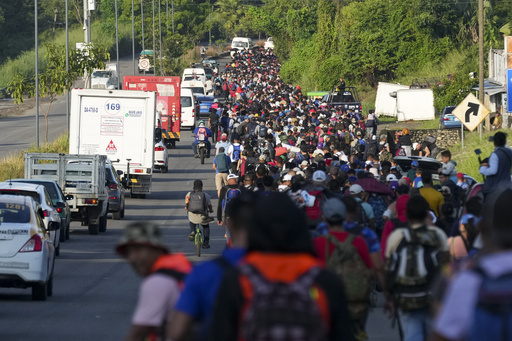Extreme weather patterns are increasingly influencing undocumented migration between the United States and Mexico, indicating that rising numbers of individuals may brave perilous border crossings as climate change intensifies conditions like drought and storms, according to a recent study.
Research published in the journal Proceedings of the National Academy of Sciences reveals that individuals from agricultural areas in Mexico are more prone to illegal border crossings following droughts, with diminished chances of returning home if extreme weather persists.
Globally, the impacts of climate change, primarily driven by the combustion of fossil fuels such as coal and natural gas, are leading to more severe weather events. Droughts are extending and intensifying, heatwaves are causing more fatalities, and storms are not only becoming stronger but also unleashing unprecedented levels of rain.
In Mexico, which has a population nearing 130 million, prolonged droughts have emptied reservoirs, triggered acute water shortages, and drastically reduced corn yields, thereby jeopardizing the livelihoods of many.
Researchers identified Mexico as a key case study for examining the connections between migration, return, and the pressures of weather-related challenges. With temperatures in the country expected to rise by as much as 3 degrees Celsius (5.4 degrees Fahrenheit) by 2060, the prospect of extreme weather is poised to result in economic hardship for rural populations that depend on rain-fed agriculture. Notably, the U.S. and Mexico together account for the largest international migration flows worldwide.
As the global climate crisis deepens, experts anticipate that migration will escalate. A report from the U.N. Intergovernmental Panel on Climate Change predicts that over the forthcoming three decades, 143 million people globally could be displaced due to rising sea levels, droughts, extreme heat, and other environmental disasters.
This migration study emerges in the context of Republican Donald Trump’s recent reelection as U.S. president. Trump has dismissed climate change as a “hoax” while advocating for the mass deportation of approximately 11 million undocumented individuals residing in the U.S.
The researchers emphasize that their findings underscore the significant role that extreme weather plays in driving migration trends. According to Filiz Garip, a study co-author and professor at Princeton University, advanced economies have contributed disproportionately to climate change, while it is the developing nations that are facing its dire consequences.
Garip stated that migration is not a choice taken lightly, explaining that individuals are increasingly forced to migrate due to climate extremes, leading to longer stays in the U.S.
The study involved an analysis of detailed daily weather records alongside data from surveys of 48,313 individuals collected from 1992 to 2018, specifically focusing on about 3,700 individuals who made their first undocumented crossing.
Examining 84 agricultural communities in Mexico that rely on weather for corn production, the researchers linked migration and return decisions to abnormal weather patterns—specifically, temperature fluctuations and rainfall during the crucial corn growing season from May to August.
Findings indicated that communities experiencing drought had higher rates of migration compared to those with typical rainfall. Additionally, individuals were less inclined to return to Mexico when their home communities were experiencing unusually dry or wet conditions, a trend affecting both recent arrivals in the U.S. and those who had been there longer.
Economic status also played a role, as individuals in better financial situations were more likely to seek migration, particularly in areas with established migration networks where connections through family or friends could provide crucial support and information.
Garip remarked that while social and economic factors contributing to migration are well-documented, this study brings attention to the disparities in climate adaptation. Extreme weather events impact people differently, with social and economic factors further influencing their experiences.
Kerilyn Schewel, co-director of Duke University’s Program on Climate, Resilience and Mobility, highlighted that some of the most vulnerable individuals are often those who are unable to escape the impacts of climate change, remaining “trapped in place.”
She added that examining regions with historical migration patterns can assist in predicting future migration flows resulting from climate-related shocks. Areas that already experience significant out-migration are likely to see increased departures as conditions worsen.
Hélène Benveniste, a professor at Stanford University, noted that the study’s use of unique, community-specific migration data sets it apart from previous research, which is seldom available. Benveniste indicated that understanding delays in return migration caused by weather stress is both important and innovative within the field.
However, challenges such as intensified surveillance and enforcement at the U.S.-Mexico border complicate the ability to return home and navigate back-and-forth migration, as pointed out by Michael Méndez, an environmental policy assistant professor at UC Irvine. Once undocumented individuals are in the U.S., they often find themselves in poor housing situations and without access to healthcare, frequently working in vulnerable sectors heavily affected by climate conditions.
As climate change continues to threaten global stability across various dimensions, experts emphasize the necessity for coordinated international efforts addressing both migration issues and climate resilience. Schewel stressed that while much focus has been placed on border security, there is a pressing need to consider the root causes of migration and the demand for immigrant labor in the U.S.
This website uses cookies so that we can provide you with the best user experience possible. Cookie information is stored in your browser and performs functions such as recognising you when you return to our website and helping our team to understand which sections of the website you find most interesting and useful.
